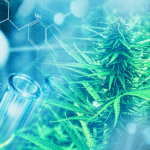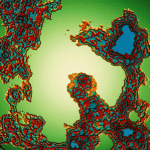Cannabinoid science touches on an astoundingly broad range of topics. With cannabinoids – endogenous, plant-derived, and synthetic – and their receptors positioned at the hub, research in the field spins out in all directions like the spokes on a bicycle wheel.
But unlike with a perfectly “true” wheel, some of these spokes bear more weight than others. They may have a stronger evidence base, as in cannabinoids’ link with inflammatory processes. Others have been subject to greater attention over the years from patients and activists outside academia, like the “legacy” medical marijuana conditions of glaucoma, nausea, and insomnia.
Recent scientific studies validate longstanding claims of therapeutic efficacy for each of these conditions that helped launch medical marijuana into the mainstream, but more is left to learn. Here are some new papers on these key spokes of the wheel.
Glaucoma
Glaucoma offers a convenient rhyme in Peter Tosh’s 1978 hit “Bush Doctor” (So legalize marijuana / Down here in Jamaica / It’s the only cure for glaucoma) and a cheap punchline at medical marijuana’s expense in many newer films and TV shows. But it’s also a serious condition affecting some 70 million people that can cause irreversible loss of vision.
Largely thanks to the efforts and 1976 court victory of Washington, D.C. activist Robert Randall, cannabis has long been known to offer short-term relief by reducing intraocular pressure. In fact, glaucoma was the first indication for which the U.S. government provided medical cannabis to a handful of patients (including Randall) beginning in the late 1970s.
But nearly half a century later, cannabis’ precise molecular mechanism of action is uncertain, and the development of cannabinoid-based glaucoma drugs remains a challenge. In a March 2022 paper in the journal Planta Medica1, researchers with Germany’s TU Dortmund University review recent findings, with an eye toward new pharmaceuticals. Among other things, they address the relative ability of different cannabinoids to reduce intraocular pressure (THC and CBN perform better than CBD, which in one experiment actually increased pressure in mice) and the distribution of CB1 and CB2 receptors, TRPV channels, and other cannabinoid targets throughout the human eye (they’re just about everywhere).
The authors also present a list of remaining research needs: more clinical studies in humans, since most to date have been in mice, pigs, or rabbits; a greater understanding of the role of the greater endocannabinoid system in the pathophysiology of the eye; and, just as importantly, the development of formulations for eye-drop delivery of cannabinoids, which are poorly soluble in water.
Nausea
Another of medical cannabis’ most common and longstanding indications is nausea. The plant has been used to treat nausea for millennia, and its ability to offset the harsh side effects of chemotherapy for cancer and AIDS was pivotal to the emergence and success of the medical marijuana movement in the 1990s. But even here more work is needed, researchers with the University of New Mexico argue in their April 2022 paper in the Journal of Clinical Gastroenterology.2 Few studies have measured real-time effects of common and commercially available cannabis-based products, they write.
Their solution? To analyze more than three years’ worth of data submitted to a smartphone app called Releaf that helps users track and optimize their cannabis consumption. Between June 2016 and July 2019, 886 people used the app to monitor a total of 2,220 self-administered, inhaled cannabis-use sessions intended to treat nausea. These records include baseline and progressive nausea ratings, allowing the researchers to retrospectively assess symptom change over time – and, more to the point, to look for associations between rate or degree of improvement and product or strain type.
More than 96 percent of users experienced symptom relief within one hour, and often within five minutes. “Among product characteristics, flower and concentrates yielded the strongest, yet similar results,” the authors write. “Products labeled as Cannabis indica underperformed those labeled as Cannabis sativa or hybrid, and joints were associated with greater symptom relief than pipes or vaporizers.”
In sessions using flower, higher THC and lower CBD content were generally associated with greater symptom relief. This is a second reminder that even beyond its pronounced psychological effects, for some physiological outcomes THC appears to have more therapeutic value than its high-profile cousin.
Sleep
Insomnia has historically been another leading driver of medical cannabis use. In a recent survey of approximately 27,000 adults in the United States and Canada, more than a quarter reported using cannabis for medical reasons; among these, 46 percent cited problems sleeping as a reason for use – slightly fewer than for the top two answers, pain (53 percent) and anxiety (52 percent3). (Remember these in case Family Feud ever asks what the “survey says” about why people use pot.)
But does it truly help? “Burgeoning evidence suggests a role of the endocannabinoid system in regulating the circadian sleep-wake cycle” … but “robustly designed studies verifying efficacy in sleep-disordered populations are limited,” write the Australia-based authors of a new review article in the journal Chest4. While some studies have shown that cannabinoids are indeed useful in insomnia disorder and sleep apnea, most studies to date are limited by small sample sizes, lack of rigorously controlled study designs, and high risk of bias, they add.
The bottom line? “While current interest in, and uptake of, medicinal cannabis use for sleep disorders may have surpassed the evidence-base, there is a strong rationale for continued investigation into the therapeutic potential of cannabinoids.” And so the wheel keeps on turning.
Nate Seltenrich, Project CBD contributing writer, is the author of the column Bridging the Gap. An independent science journalist based in the San Francisco Bay Area, he covers a wide range of subjects, including environmental health, neuroscience, and pharmacology. © Copyright, Project CBD. May not be reprinted without permission.
Footnotes
- https://www.thieme-connect.com/products/ejournals/abstract/10.1055/a-166…
- https://journals.lww.com/jcge/Abstract/2022/04000/The_Effectiveness_of_C…
- https://link.springer.com/article/10.1007/s00213-021-06047-8
- https://journal.chestnet.org/article/S0012-3692(22)00895-9/pdf
Recommended Readings
Cannabis & Sleep Disturbances
What role does the endocannabinoid system play in sleep? Can cannabis help you sleep better?
Managing Nausea with Cannabis
CBD and CBDA interact with serotonin receptors to ease nausea and vomiting.
CBN for Sleep: Fact or Fiction?
A molecular biologist deconstructs a cannabis industry myth.










